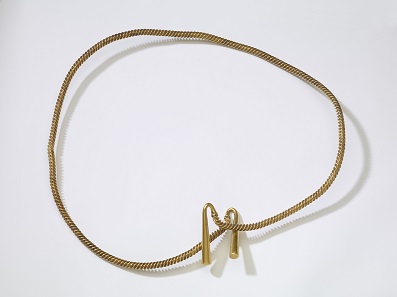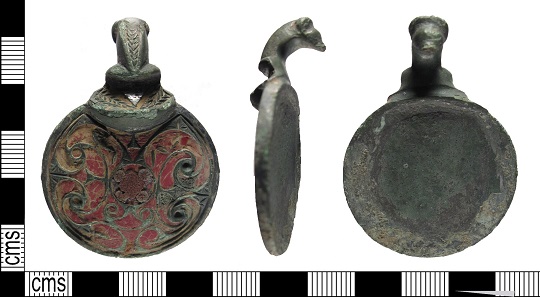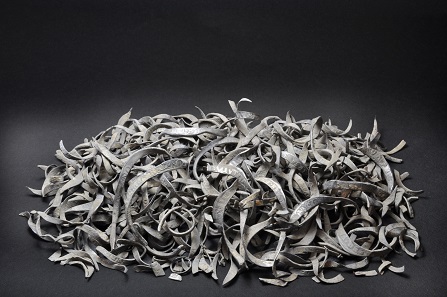December 1, 2016 – At the launch of the Portable Antiquities Scheme (PAS) and Treasure annual reports at the British Museum, Matt Hancock, Minister of State for Digital and Culture, announced the recording of a further 82,272 archaeological finds made by the public in 2015. Finds discovered include a Bronze Age gold torc (the largest ever found), a beautifully enamelled Anglo-Saxon mount and an intriguing hoard of silver coin clippings deposited in the late 17th century. These finds, and others, are rewriting the archaeology and history of Britain and enabling people across the county to learn more about the past of their local area.
Bronze Age gold torc or armlet from Cambridgeshire (CAM-E5D871), which dates to circa 1300-1100 BC. This example survives as a single hoop, rather than being coiled. It has a three-flange twisted body and plain recurving terminals which expand gently towards the ends. Speaker: Expert, BM curator of European Bronze Age. © The Trustees of the British Museum.
More than 1,000 new treasures
A further 1,008 Treasure finds have been reported this year in England, Wales and Northern Ireland, of which the most significant have been acquired by museums across the country; next year the British Museum with its local partners will be celebrating 20 years since the Treasure Act came into force, and the establishment of the PAS.
20 years PAS – 1.2 million archaeological finds
The PAS has recorded over 1.2 million archaeological finds to date (since 1997). This data has been widely used by academics, students and many others by searching the PAS database. PAS data has been used in over 528 research projects, including 25 pieces of large-scale reaserch and 110 PhDs.
The PAS is a partnership project, managed by the British Museum working with at least 119 national and local partners to deliver the Scheme’s aims. It is an important part of the British Museums’ National Programmes activity which extends across the UK.
PAS-like initiatives spreading abroad
As part of the HLF funded project PASt Explorers, the PAS is working with volunteers across the country to record archaeological finds made by the public and get involved in archaeology. In 2015, 259 volunteers, including 100 self-recorders (metal-detectorists who record their own finds on the PAS database), have contributed to the work of the Scheme.
The PAS is now working closely with other Europe areas, including Denmark, Flanders and the Netherlands, where initiatives are underway to record archaeological finds made by the public. Also there are plans for these recording schemes to work even closer together, to share information about archaeological discoveries and recording them. A North Sea Area finds recording group has been recently established to take this forward.
Tracey Crouch, Minister for Heritage, said: “The Portable Antiquities Scheme enables us to learn more about our nation’s history and preserve and safeguard treasure for generations to come. New discoveries keep getting made every year through the scheme that then find their way into our wonderful museums across the country.”
Hartwig Fischer, Director of the British Museum, said “The British Museum is a world museum but it is also a museum for Britain. The PAS contributes enormously to our National Programme activity and our work across the country. It is an amazing partnership, drawing together over 100 local museums and other organisations to deliver the Scheme’s aims of recording the past to advance knowledge and sharing that knowledge with all”.
At the launch of the Portable Antiquities Scheme and Treasure annual reports at the British Museum these three recent findings were presented:
Detail of the Bronze Age gold torc or armlet from Cambridgeshire, which dates to circa 1300-1100 BC. © The Trustees of the British Museum.
Bronze Age gold torc or armlet from Cambridgeshire (CAM-E5D871), which dates to circa 1300-1100 BC. Gold torcs were fashionable jewellery in both Britain and Ireland during this period but this example, found in 2015, is one of the most important and spectacular ever found. The weight of the gold torc (732gms) is exceptional and it is one of the largest ever found in Britain and Ireland. The torc is made of 86% (20 carat) gold, making it very soft. However, detailed study by scientists at the British Museum found very little evidence of use on the solid gold terminals used to fasten the torc together. This raises questions regarding its original use and meaning. Torcs are usually worn around the neck but the Cambridgeshire torc is probably too large to fit even the largest waist (extended it measures c.126cms). It may have been designed to be worn over thick winter clothing or as a sash worn across the body, or may not of been intended to be worn by a human at all, it may instead have been worn by a prized animal (perhaps in the course of animal sacrifice). The absence of torcs in burials means that their function remains mysterious.
Anglo-Saxon hanging bowl mount dating to AD 600-725 with a zoomorphic terminal. Expert: Helen Geake, PASt Explorers team. © The Littlehampton Museum.
Anglo-Saxon hanging bowl mount from West Sussex (SUSS-F9E7AA), which dates to AD 600-725. The mount is decorated intricately with swirling motifs set against bright red enamel and millefiori glass inlay, recalling aspects of the large hanging bowl from the famous Sutton Hoo burial. The hook at the top is moulded delicately into an animal’s head, which would have peered over the bowl’s edge. The mount is beautifully preserved and of fine quality. It featured in the British Museum’s ‘Celts’ exhibition and was donated by the finder to Littlehampton Museum.
Hoard of 463 silver coin clippings and fragments from Gloucestershire deposited in about the 1640s, during the English Civil War. Expert: Barrie Cook, BM Medieval coin curator. © The Trustees of the British Museum.
A large, rare, hoard of 463 silver coin clippings and fragments from Gloucestershire (GLO-0794E0) deposited probably around the time of the Great Recoinage of 1696. One consequence of the decision to recall from English currency all the pre-1662 hand-struck coinage and turn it into machine-struck coins was a bout of clipping of the older money, removing silver from the edge. All the clippings in this hoard show the complete removal of the inscription from the coins. These are half-crowns, shillings and sixpences from the period 1554 to 1662. Coin clipping was a criminal activity and perpetrators faced the death penalty.
This is the official Portable Antiquities Scheme website.
Last year PAS was threatened by drastic financial cuts as we reported.








